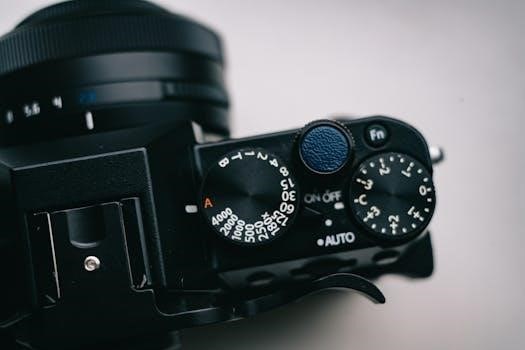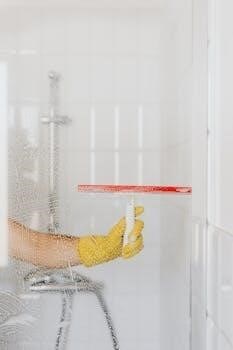The L-Acoustics K2 rigging system is designed for safe and efficient deployment of K2 enclosures. This system approach provides packaged solutions for predictable performance at all stages⁚ modeling‚ installation‚ and operation‚ ensuring ease of use.
Overview of the K2 System Approach
The L-Acoustics K2 system approach focuses on providing comprehensive‚ integrated solutions for loudspeaker systems. This method ensures the highest level of performance and predictability from the initial modeling phase through installation and operation. The system includes enclosures‚ rigging‚ amplified controllers‚ cables‚ and software applications‚ all designed to work together seamlessly to achieve optimal results‚ simplifying the process for users with a packaged solution.
Safety Instructions for K2 Rigging
Adhering to all safety guidelines is paramount. Always read the manual‚ follow instructions‚ and never use unapproved equipment. Safety slings should be used at all times‚ and the WLL must be respected.
Importance of Following Safety Guidelines
Following safety guidelines is crucial when using the L-Acoustics K2 rigging system. Ignoring these instructions can lead to serious accidents‚ equipment damage‚ and potential injury to personnel. Always adhere to all warnings and never use unapproved accessories or components. The K2 rigging manual must be carefully read to ensure a safe and successful operation. Prioritizing safety is essential for every installation.
Approved Equipment and Accessories
Using only L-Acoustics approved equipment and accessories is vital for the safe operation of the K2 rigging system. Never use non-approved components as this can compromise the integrity of the setup. The K2 rigging system includes specific elements like the K2-BUMP and K2-LINK. Ensure that all components are compatible and in good working condition. Refer to the K2 manual for a complete list of approved items and their proper usage.

K2 Rigging Components
The K2 rigging system comprises various elements including the K2-BUMP‚ K2-LINK‚ and associated hardware. These components are essential for flying and ground-stacking K2 enclosures safely and efficiently‚ ensuring proper system performance.
Description of Rigging Elements
The K2 rigging system includes several key elements designed for versatile deployment options. These elements consist of the K2-BUMP‚ a frame for flying K2 arrays‚ and the K2-LINK‚ a rigging accessory for rear attachment. The system also incorporates various pins‚ shackles‚ and slings. These components‚ manufactured with high-quality materials‚ ensure safe and reliable rigging. The system’s design allows for compatibility with K1 and K1-SB systems‚ providing enhanced flexibility in system configuration for diverse applications.
K2-BUMP and its Functionality
The K2-BUMP is a crucial component of the rigging system‚ serving as the primary structure for flying K2 arrays. It’s designed to be compatible with K1 and K1-SB systems‚ enhancing system versatility. The K2-BUMP includes an extension sling and a laser adapter to assist in precise alignment. This robust frame is engineered to handle substantial loads while maintaining system integrity and safety. Furthermore‚ it allows for various site angles by using specialized rigging bars‚ offering adaptability to diverse venue requirements.
K2-LINK Rigging Accessory
The K2-LINK is a specialized rigging accessory designed for rear attachment of K2 enclosures when they are positioned below K1 systems. This accessory facilitates the integration of different L-Acoustics enclosure types within the same array. The K2-LINK is essential for creating hybrid line sources‚ ensuring proper alignment and load distribution. It provides a secure and reliable connection‚ maintaining the structural integrity of the combined array‚ and helps to achieve consistent sound coverage.
Rigging Procedures
Proper rigging procedures are crucial for safe K2 system deployment. This section outlines the steps for flying K2 arrays and provides guidelines for ground-stacking configurations‚ ensuring secure and reliable setups.
Steps for Flying K2 Arrays
Flying K2 arrays involves several critical steps‚ starting with attaching the K2-BUMP to the top enclosure. Ensure all pins are securely fastened and use the K2-LINK for rear attachments when needed. Carefully lift the array‚ paying close attention to the working load limits. Always use safety slings as a precaution and follow the specific instructions from the rigging manual for a safe and successful deployment.
Ground-stacking Guidelines
Ground-stacking K2 arrays requires careful attention to stability and safety. Ensure the supporting surface is level and capable of bearing the weight of the stacked enclosures. Do not stack the enclosures beyond the recommended height limits‚ and use appropriate stabilizing accessories if necessary. Exercise extra caution to prevent tipping‚ and always refer to the K2 rigging manual for specific instructions and guidelines to ensure safe operation during ground-stacking.
LA-RAK Integration with K2 Rigging
The LA-RAK is designed to integrate seamlessly with the K2 rigging system using the K2-RACKMOUNT. This allows for stacking LA-RAKs on top of flown K2 arrays‚ optimizing space and cable management.
K2-RACKMOUNT Description and Use
The K2-RACKMOUNT is a rigging interface designed for stacking one or two LA-RAK units on top of a K2 array that is flown using a K2-BUMP. This steel component‚ coated for anti-corrosion‚ weighs 3.3 kg (7.3 lbs) and facilitates the integration of amplification and processing directly with the flown loudspeaker system. It allows for convenient and secure mounting‚ streamlining the overall setup.
Stabilizer for LA-RAK on Top of K2 Array
A stabilizer is essential when mounting two LA-RAK units side-by-side atop a K2 array that is flown with the K2-BUMP. This component ensures the secure and stable positioning of the LA-RAK amplifiers‚ preventing movement or shifting. It is designed to work in conjunction with the K2-RACKMOUNT‚ providing a reliable platform for the LA-RAK units and maintaining the integrity of the overall rigging system.
Mechanical Limits and Safety Assessment
Understanding the Working Load Limits (WLL) is critical for safe operation. Rigging components must be assessed for any signs of damage‚ including bends‚ breaks‚ or loose parts‚ to ensure structural integrity.
Understanding Working Load Limits (WLL)
The Working Load Limit (WLL) is a crucial safety parameter that specifies the maximum weight a rigging component can safely support. It is imperative to adhere to the specified WLL for each component within the K2 system to prevent equipment failure and ensure the safety of personnel. Never exceed these limits. Always refer to the relevant documentation for detailed WLL information. Understanding the WLL is paramount for safe rigging practices and must be followed strictly.
Assessing Mechanical Safety of Rigging System
Before each use‚ a thorough inspection of all K2 rigging components is vital for mechanical safety. Check for any signs of damage‚ bends‚ breaks‚ or missing parts that could compromise the system’s integrity. Ensure that all fasteners are securely tightened and no parts are loose. If any issues are identified‚ the equipment must be taken out of service until repairs are made. This careful assessment is essential to maintain a safe and reliable rigging system.
Additional Rigging Considerations
L-Acoustics recommends using safety slings at all times for added security. When ground-stacking‚ extreme caution is needed to prevent unstable configurations. Always adhere to the recommended guidelines.
Use of Safety Slings
The use of safety slings is highly recommended by L-Acoustics as a crucial measure for ensuring the security of the K2 system during rigging. These slings provide a redundant support‚ preventing potential falls in the event of primary rigging failure. Always inspect slings before use‚ ensuring they are in perfect condition without any visible damage. Employing safety slings is a fundamental practice for maintaining a safe working environment while working with the K2 system. It is a must to use them.
Cautions for Ground-stacking
When ground-stacking K2 loudspeaker arrays‚ extreme caution must be exercised to prevent instability. Never stack the enclosures beyond the recommended height‚ as exceeding these limits could lead to tipping or collapse. Ensure the ground surface is level and stable before beginning the stacking procedure‚ and always use appropriate supports to secure the stack. Proper ground-stacking is essential for the safety of personnel‚ and improper practices can result in serious accidents. Always prioritize safety by following strict guidelines.
K2 System Specifications
The K2 system has a frequency range of 35 Hz to 20 kHz. A recommended ratio is 3 K2 to 1 K1-SB. Minimum line length requirements include 12 K2 or 4 K1-SB enclosures.
Frequency Range and Recommended Ratios
The L-Acoustics K2 system boasts a frequency range spanning from 35 Hz to 20 kHz‚ providing a full spectrum audio experience. When deploying the K2 alongside the K1-SB subwoofer‚ a recommended ratio of 3 K2 enclosures for every 1 K1-SB is advised. This ratio helps maintain optimal tonal balance and sound pressure levels within the array‚ ensuring consistent coverage and performance.
Minimum Line Length Requirements
To achieve optimal performance with the L-Acoustics K2 system‚ it is important to adhere to minimum line length requirements. When configuring a K2 array in conjunction with the K1-SB subwoofer‚ a minimum of 12 K2 enclosures and 4 K1-SB subwoofers are required to form a cohesive line source. These minimum lengths ensure proper coupling and consistent coverage for the audio system‚ maximizing the performance of the array.

L-Acoustics Software Applications
L-Acoustics software applications are essential for system modeling and installation. These tools help in predicting the performance of K2 arrays‚ ensuring optimal coverage and sound quality during the setup process.
Use in System Modeling and Installation
L-Acoustics software plays a crucial role in the pre-event phase‚ allowing users to accurately model K2 array configurations. This modeling process helps predict sound coverage‚ optimizing loudspeaker placement for the venue. The software also assists with installation‚ ensuring proper rigging angles and system setup‚ streamlining the overall process and contributing to a successful event by saving time and resources.

Transportation and Storage
Specific accessories‚ such as the L2-BUMPFLIGHT case‚ are available for the safe transportation and storage of K2 rigging elements. These ensure the longevity of the components‚ safeguarding them during transit.
Accessories for Storage and Transportation
For the convenient and secure handling of the K2 rigging system‚ L-Acoustics provides various accessories. These include specialized flight cases like the L2-BUMPFLIGHT‚ designed to accommodate the K2-BUMP and related rigging components. These cases ensure that all parts are protected from damage during transportation and are also neatly organized for storage when not in use. The use of these accessories is crucial for preserving the integrity of the rigging equipment.
Maintenance and Inspection
Regular maintenance and inspection are crucial for the K2 rigging system. Checks should include identifying missing or loose parts and also looking for any signs of damage to rigging components‚ ensuring safe operation.
Identifying Missing or Loose Parts
A thorough inspection process must be implemented to identify any missing components within the K2 rigging system. This includes checking for the presence of all pins‚ bolts‚ and safety clips as specified in the manual. Furthermore‚ all fasteners should be examined to ensure they are properly tightened and not exhibiting any looseness. Pay special attention to connections between the K2-BUMP‚ K2-LINK‚ and loudspeaker enclosures.
Identifying Damaged Rigging Parts
Careful visual checks are crucial to identify damaged parts within the K2 rigging system. Look for any signs of bending‚ breaks‚ cracks‚ or deformation on rigging elements such as the K2-BUMP and K2-LINK. Inspect all steel components for corrosion or wear. Pay attention to areas with high stress‚ such as connection points. Any damaged parts must be immediately replaced to ensure safe operation‚ referring to the manual for replacement procedures.

Documentation and Resources
Access the K2 owner’s manual and rigging manual for detailed instructions. These documents provide essential information for safe and correct system operation. Declaration of Conformity details are also available.
Accessing K2 Owners Manual and Rigging Manuals
The L-Acoustics website provides access to the K2 owner’s manual and rigging manual in PDF format. These documents contain crucial safety instructions‚ rigging procedures‚ and system specifications. Users should download and thoroughly review these manuals before operating or rigging the K2 system‚ ensuring they adhere to all guidelines and warnings for safe and optimal performance. Always refer to the latest versions available.
Declaration of Conformity Information
The L-Acoustics K2 system comes with a Declaration of Conformity‚ affirming its compliance with relevant safety and performance standards. This document is essential for demonstrating that the K2 system meets all necessary regulatory requirements. The Declaration of Conformity is typically available on the L-Acoustics website and should be consulted to verify the system’s compliance before operation and to ensure all safety protocols are followed‚ regarding the rigging system.
